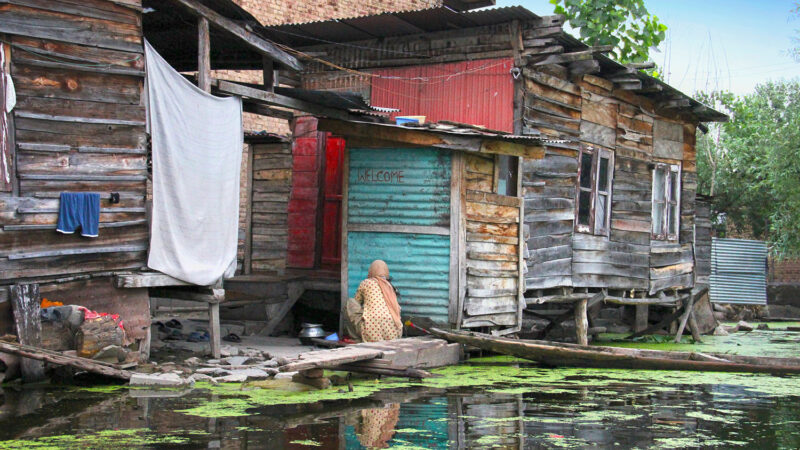Flooding in Pakistan: where vulnerability meets climate change, devastation can follow
In the wake of the massive flooding in Pakistan, Fahad Saeed and Manjeet Dhakal explain how socioeconomic factors intersect with climate impacts in South Asia, compounding their effects on people and the environment. Based on the latest evidence from the IPCC, they break down what risks could emerge in the coming decades if warming is not limited to the Paris Agreement’s 1.5°C threshold.
Share

In the last six months, South Asia has gone from experiencing unprecedented heatwaves to heavy rains and flooding that has affected millions of people: decimating infrastructure in urban and rural areas, wiping out vast swathes of agriculture, and resulting in human fatalities. Both of these extreme events have been attributed to climate change.
Where climate impacts intersect with existing socioeconomic vulnerabilities, they become more devastating.
Earlier this year, the Intergovernmental Panel on Climate Change published its Working Group II report on Impacts, Adaptation and Vulnerability. In it, the IPCC identified South Asia as a global hotspot for both climate risk and high human vulnerability.
South Asia is home to almost 25% of the world population and accounts for 29% (216 million) of the global population living in extreme poverty, with a significant number of people unable to access essential services. The region faces governance challenges, wealth and gender inequalities, conflicts, and is dependent on climate-sensitive livelihoods. Many of these challenges can be attributed to historical patterns of inequity, such as colonialism.
When these risks interact, new sources of vulnerability to climate hazards are generated, compounding the overall risk. The IPCC tells us that for South Asia, this looks like:
More intense extreme weather events
As the recent heatwave, monsoon rains and flooding show, extreme weather events will continue to increase in intensity and frequency at current levels of warming (1.1°C). Because of South Asia’s limited adaptive capacity, there are significant knock-on effects from these impacts.
In the past decade, deaths from extreme events have been reported to be 15 times higher in countries with high vulnerability than in those with low vulnerability. Extreme weather events will also increase the risk of food insecurity, leading to further climate-related fatalities.
Water scarcity
Both climatic and non-climatic drivers, such as socioeconomic changes, have created water stress conditions in both water supply and demand. The agricultural sector, the mainstay of many livelihoods in the region, is particularly impacted.
Food insecurity will be further compounded by climactic and socioeconomic changes that stress water conditions in the region. Glacier shrinkage in the Hindu Kush-Himalaya (HKH) region since 2006 means reduced meltwater for future use. Severe water scarcity challenges in the Indus and Ganges river basins will lead to further drought conditions by the end of the century.
The impact on biodiversity can also be seen along South Asia’s mangroves and 9000 km of coastline. Warming at 2°C or more risks irreversible loss of coral reefs and other marine ecosystems, while pollution, land use change, and sea level rise threaten the region’s mangroves.
Urban areas under increased pressure
The impacts associated with climate change on South Asia’s coastline extend to its highly populated cities. Higher risks from extreme precipitation are projected for almost all cities in the region, leading to significant economic loss to coastal cities between now and 2050.
Moreover, extreme heat will increase the urban heat island effect in almost all South Asian cities. Millions of urban dwellers could be affected by extreme heat more than 30 days per year, with the most significant impact on the poorest residents.
Health and migration impacts
Warming will also adversely impact health in the region, leading to increased diseases, malnutrition, mental disorders, and heat-related deaths. Specifically, the combination of heavy rain and temperature increases will accelerate the risk of diarrheal diseases, dengue fever and malaria while also causing price hikes in food due to decreased food availability.
These extreme weather events are already driving migration. In 2019, Bangladesh and India each recorded more than four million people displaced in disasters, a number that will increase as climate change worsens.
Loss and Damage
In addition to these compounding impacts, climate change is already causing loss and damage across the region, affecting areas from infrastructure to supply chains. Higher levels of warming will only worsen the impacts.
Non-economic loss and damage, such as cultural traditions, are reported to a lesser degree due to underreporting and methodological issues with detection and attribution to climate change – but this doesn’t mean that it isn’t happening. There is a crucial knowledge gap in the region regarding loss and damage, making it challenging to assess comprehensively.
Melting glaciers
Mountainous regions are at the forefront of climate impacts. The IPCC report confirms that the rate of ice sheet loss increased by a factor of four in the last three decades. The current rate of ice sheet loss, with almost all of the world’s glaciers retreating synchronously since the 1950s, has been unprecedented in at least the last 2,000 years.
The unprecedented pace of glacier retreat on the global scale is more alarming in the region. The Hindu Kush Himalaya Assessment report by ICIMOD confirmed that even if global warming is limited to 1.5°C, temperatures will remain at least 0.3°C higher in the Hindu Kush Himalayas (HKH) and at least 0.7°C higher in the northwest Himalaya and Karakoram regions of Pakistan. Consequently, 36% of the glaciers in the region will be gone by 2100. And this is the “best case” scenario where the world manages to limit warming to 1.5°C and avoid the worst impacts of climate change. Rapid ice sheet melt could lead to catastrophic sea level rise even before the end of the century.
The way forward
If global warming rises above 1.5°C, compounding risks and impacts will push climate-resilient development in the South Asia region out of reach. Urgent and steep emissions reduction and adaptation funding remain key to economic development and human prosperity.
Climate risks, vulnerability and adaptation measures need to be factored into decision-making across all levels of governance. Significant barriers to climate-resilient development include fragmented and reactive governance, inadequate evidence on which actions to prioritise, and finance deficits.
However, there are many opportunities for South Asian countries, including promoting investment in renewable energy, enhancing water harvesting and adopting green building technologies.
To assist the region’s governments and stakeholders in taking these opportunities, we are formalising our already decades-long presence in South Asia by opening an office in Kathmandu, Nepal. We will continue our work providing science-based support to governments and stakeholders in implementing adaptation and mitigation-focused projects and engaging with our partners and networks in the region.













